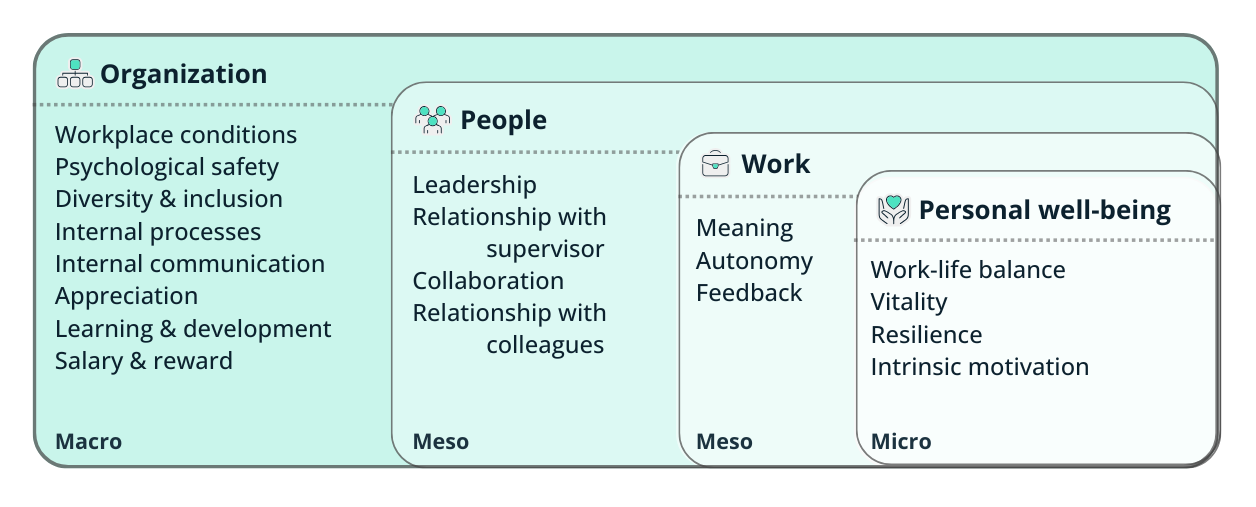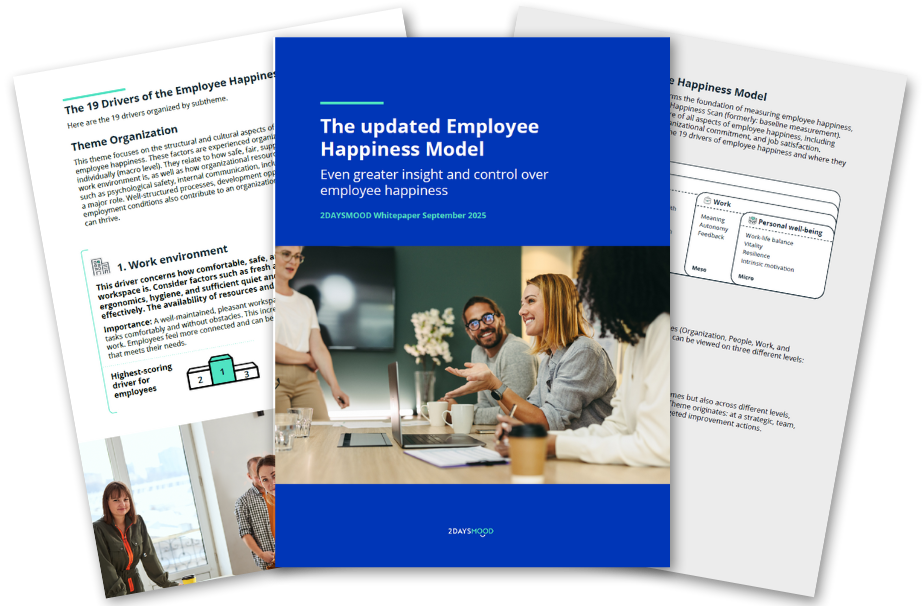The Employee Happiness Model reveals the score and the importance of the drivers behind employee happiness.
Happy employees are the golden formula for a successful organization. They work with contagious energy and productivity, and create happy customers. Based on scientific research and statistical validation, we developed the Employee Happiness Model.

Our validated methodology
The key pillars of our methodology are the Russell’s Circumplex Model, eNPS, and the Employee Happiness Model with its 19 drivers of workplace happiness.
Using the Russell’s Circumplex Model, we measure mood and stress levels within the organization. The eNPS measures how engaged and committed your workforce is. Through the drivers from our Employee Happiness Model, you can take concrete actions to increase employee happiness (such as improving workplace culture, and other initiatives aligned with your strategy).
Want to learn more about our approach? Schedule a meeting with us.
Employee Happiness Model: the 19 drivers of employee happiness
 Organization
Organization
 1. Workplace conditions
1. Workplace conditions
A positive work environment involves having a comfortable, safe, and functional physical workspace. This includes essentials such as fresh air, proper lighting, good acoustics, ergonomic furniture, hygiene, and the availability of quiet spaces that support focus and concentration. Access to necessary tools and facilities is also a key factor.
 2. Psychological safety
2. Psychological safety
Psychological safety means feeling free to speak openly, share ideas, ask questions, and make mistakes without fear of negative consequences. It's about working in a team environment built on trust, empathy, and mutual support, where both colleagues and leaders encourage you to be your authentic self.
 3. Diversity & inclusion
3. Diversity & inclusion
Diversity and inclusion are about creating a workplace where everyone feels welcome, valued, and respected, regardless of background, gender, age, orientation, or other personal characteristics. An inclusive organization promotes equal opportunities, fair treatment, representation, and a culture that embraces and leverages differences.
 4. Internal processes
4. Internal processes
Internal processes refer to how fair, structured, and transparent decision-making, policies, and regulations are within the organization. Employees value clarity and consistency in procedures and trust that decisions are made transparently and internal services are delivered efficiently.
 5. Internal communication
5. Internal communication
Effective internal communication ensures that employees feel informed and involved in organizational updates. This includes clear communication channels with colleagues and leaders, transparency, active information sharing, and the use of effective communication tools. Two-way communication is essential.
 6. Appreciation
6. Appreciation
Appreciation refers to feeling acknowledged and supported for your efforts and achievements. This can come in the form of personal recognition, public praise, celebration of milestones, or simple words of thanks. A culture that recognizes employees and values meaningful gestures, such as well-prepared farewells, strengthens overall satisfaction and belonging.
 7. Learning & development
7. Learning & development
This driver focuses on the opportunities employees have to develop professionally within the organization. Access to training, mentorship, career progression, and on-the-job learning is essential. A stimulating environment that encourages skill development and offers time and space for growth helps retain motivated and future-proof employees.
 8. Salary & reward
8. Salary & reward
Compensation includes not only base salary but also secondary benefits such as vacation days, pension plans, bonuses, and other perks. It’s important for employees to feel fairly rewarded based on their performance, contributions, and market standards.
 People
People
 9. Leadership
9. Leadership
Leadership involves how managers support, inspire, and empower their teams. Strong leaders are trustworthy, set a good example, and encourage employees to reach their full potential. Leadership should be inclusive, supportive, and focused on creating a collaborative work culture.
 10. Relationship with supervisor
10. Relationship with supervisor
This driver measures the quality of the relationship between employees and their direct supervisors. A strong relationship is built on trust, active support, open communication, and constructive conflict resolution. A manager who is accessible and acts as a coach creates a positive and reliable foundation.
 11. Collaboration
11. Collaboration
Collaboration is about how well team members work together, whether there's mutual support, clear communication, and shared responsibility for tasks and decisions. It also covers how teams handle conflicts and encourage collective problem-solving.
 12. Relationship with colleagues
12. Relationship with colleagues
This area focuses on the quality of interpersonal relationships among coworkers. Feeling connected, respected, and informed by colleagues contributes to a positive work atmosphere based on trust and honesty.
Work
 13. Meaning
13. Meaning
Meaningful work goes beyond daily tasks, it’s about feeling that what you do makes a difference. This includes having a sense of contribution, using diverse skills, understanding the whole work process, and being proud of the impact your work has inside and outside the organization.
 14. Autonomy
14. Autonomy
Autonomy is about having the ability to decide how, when, and what you work on. Employees who experience autonomy feel empowered, have control over their tasks and schedule, and are trusted by leadership to work independently.
 15. Feedback
15. Feedback
Effective feedback is timely, clear, and focused on growth. A culture that supports open and constructive feedback helps employees learn and improve continuously. It also fosters a safe environment to reflect, adjust, and develop professionally.
 Personal well-being
Personal well-being
 16. Work-life balance
16. Work-life balance
Work-life balance refers to how well employees can manage the demands of work alongside their personal lives. It includes having space for rest, personal responsibilities, and the freedom to take time off without guilt. A supportive team culture helps maintain healthy boundaries.
 17. Vitality
17. Vitality
Vitality refers to emotional, social, physical, and mental energy at work. A healthy lifestyle, combined with sufficient rest and recovery, is essential for staying energized and resilient throughout the workday and beyond.
 18. Resilience
18. Resilience
Resilience is about how well employees cope with setbacks and stress at work. It involves perseverance, flexibility, and receiving support from the work environment. Resilience helps employees stay strong and adapt to change effectively.
 19. Intrinsic motivation
19. Intrinsic motivation
Intrinsic motivation refers to doing work because it brings joy, interest, and fulfillment. When employees feel personally engaged and enthusiastic about their tasks, they naturally perform with greater energy and commitment.
Contact us for free advice or a demo
Do you want to increase workplace happiness in your teams? Gather feedback on a specific topic? Monitor stress in real time? Or do you need a baseline measurement to determine the drivers of your culture?
We are happy to help with your specific challenge and provide you with:
- Our expertise, experience, and energy!
- A demo of the tool
- Advice on application in your organization
- The opportunity to try it for free

